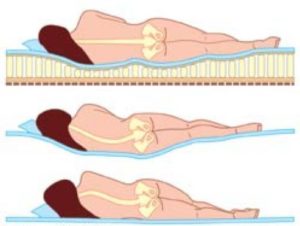4 Tips on selecting the right mattress.
 Choosing the right mattress is simple when you know what you are looking for.
Choosing the right mattress is simple when you know what you are looking for.
This article is long overdue.
As I consult people about their necks and backs, it almost always comes up: ‘Maybe it’s my mattress?’ or ‘Maybe it’s my pillow?’
Tip number 1: Don’t blame the mattress too quickly.
Firstly, don’t blame the mattress too quickly.
People often blame their mattress for their neck or back pain because they are kept awake with pain. Simply because the night time is when the pain occurs means the mattress is the assumed culprit. In reality, most people who get neck or back pain at night have problems in their back that are there 24/7 and may have been there for years. The fact that you get symptoms at night and not during the day is very common. In most cases, good treatment to fix the muscles in the neck and back means even with no mattress replacement, the nightly pain is gone.
So before you rush out and spend thousands on that mattress that Marjory said ‘saved her life!’ get some treatment. It’s a whole lot cheaper. In most cases good Myotherapy will solve the pain despite the mattress. If however treatment only gets temporary results, then the mattress is one of the factors worth discussing.
Tip number 2: It’s all about support!
Okay. So you have decided to rush out and buy a new mattress. What do you look for?
 A mattress is a friend to your back when it contours to the shape of your body.
A mattress is a friend to your back when it contours to the shape of your body.
In this way, it supports you well, giving where it needs to and holding up where it should.
Check out the first image above.
Notice how the foam of the mattress depresses at the shoulder and again at the hips. In this way it contours to the shape of the body and enables the spine to rest in a neutral, or straight position.
Notice in the second image, the mattress sags in the middle giving no support and in the third, the mattress does not give at all, again twisting the spine. You want the first.
Tip number 3: The foam is the expensive bit.
The reality is that it is the first 1-2 inches of the mattress that does this contouring. In other words, that 1-2 inch layer of foam on the top does all the important work and good quality foam is expensive.
How do I know this? From speaking first-hand to a patient who is, in fact, a mattress manufacturer. He assured me that this is the most expensive part of the mattress. You want a foam that will not collapse, but contour. 
The best type of foam for this is foam with no memory. ‘Memory’ describes when you push into the foam and the imprint stays. So high quality foam, like latex, has little or no memory. This is the best stuff.
High quality foam will give as shown in the first image, but will return to the original shape.
Poor quality foam will develop a permanent imprint over time. In other words, it remembers your shape. This is not good. You want the foam to contour to your body shape afresh every time you lie down.
Tip number 4: The rest of the mattress doesn’t matter as much.
The other parts of your mattress are less important. The base or frame your mattress sits on needs to provide a flat, firm surface. That’s all it needs to do.
The springs in your mattress do not contour, they simply exist to provide a flat surface for your top layer of foam to work on. That’s all they need to do.
Don’t waste your time with fluffy materials in the top of the mattress that feel nice while it’s on the shop floor. Materials like wool, feather or synthetic fill are all just ‘fluff’.
So what do I ask for?
An inner spring mattress, with a high quality layer of foam on top, preferably latex, about one inch thick if you are a small frame or up to two inches thick if you are a bigger frame. If you can get that layer of foam on both sides of the mattress then you can rotate it and give the mattress an even longer life.
One more thing. Buy from a local manufacturer if you can. They know exactly what is in the product and they have to stand by it.
While you’re out shopping, check out 5 tips on which is the right pillow.
And if you’re reading this in bed as you lay awake in pain, I must tell you to stop: ‘Don’t read this in bed!’


